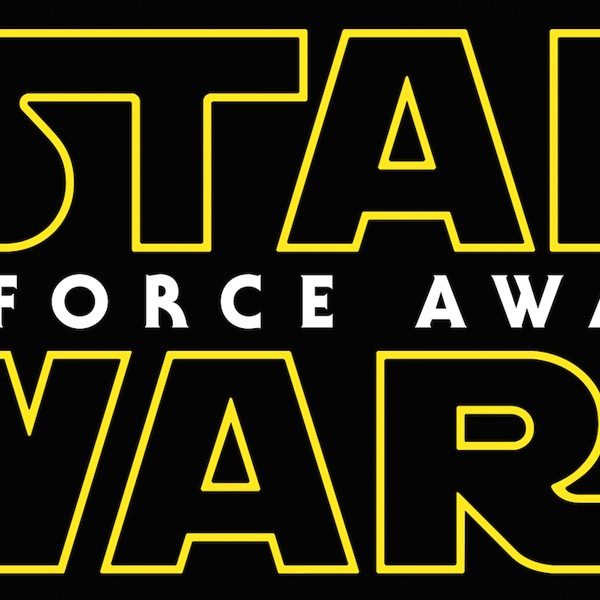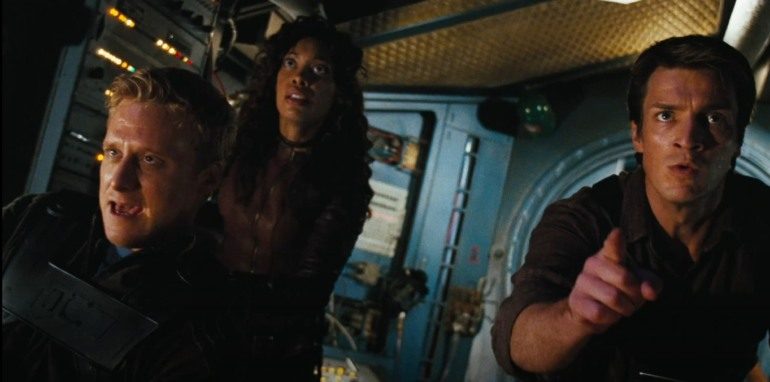

Serenity is an anomaly of a movie. Name one other instance where a show gets canceled halfway through its first season, and then the head of a major studio walks up to the show creator with a $40 million check (with $100 million crossed out) and says, Be like Cody Rhodes and finish the story. Yeah, that probably hasn’t happened twice. It didn’t even happen once, considering this hypothetical technically would’ve taken place before 2005, so that’s a good twenty years before that reference would’ve made any semblance of sense. What if the filmmaker doesn’t watch wrestling? Maybe he’s questioning why a studio head is hand-delivering an entire film budget in the form of a personal check. Is he supposed to deposit it in his checking or savings account? Shouldn’t there be a lawyer present? Did they plan a meeting, or did they randomly run into each other, and the studio head was like, Oh, that’ll save me a trip later. Nothing about this made-up story makes sense when you get into the details of the transaction… not sure how to transition this smoothly after going down that weird rabbit hole, so let’s start over.
Serenity was written and directed by original Firefly showrunner Joss Whedon and acts as the continuation and conclusion of the canceled cult classic TV series (also known as the thing that’s better than whatever show you’re currently watching). The film follows Captain Malcolm Reynolds and his ragtag crew as they’re on the run from the galactic government, The Alliance, who are actively pursuing two passengers aboard the ship. Along the way, they get into some space battles, fight rage-zombies with the capacity to fire weapons and fly ships, and in the end, learn that the true “Midbulk transport, standard radion-accelerator core, class-code 03-K64: Firefly” was inside them all along.
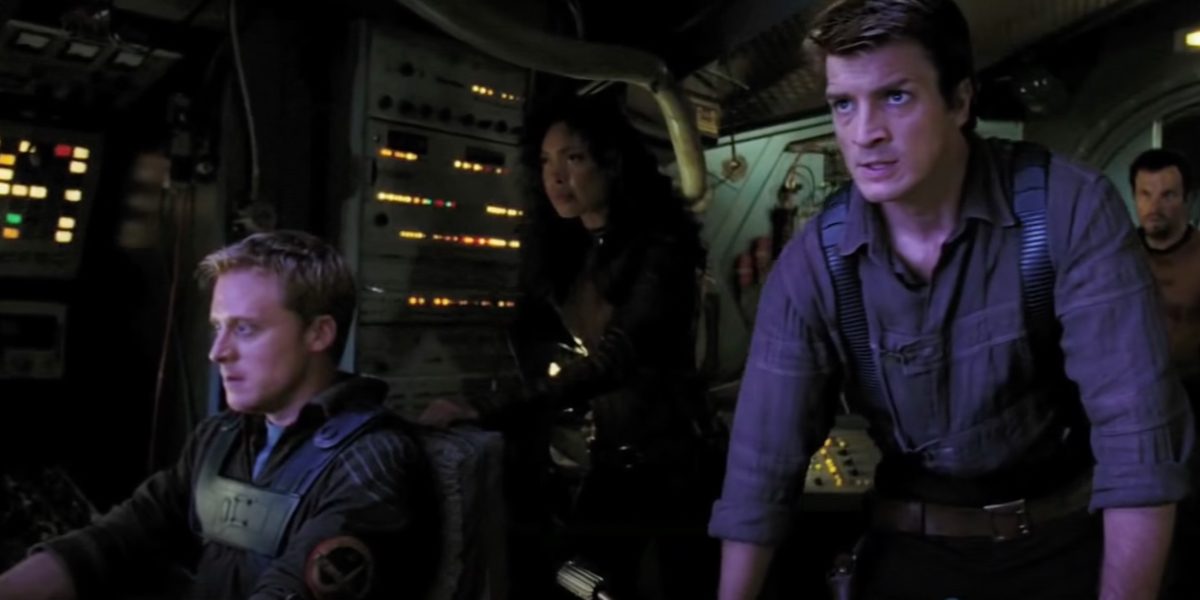

The film had an arduous task, not unlike what Whedon would later do with the original Avengers film. That’s to re-introduce characters to craft a story to satisfy an established fanbase so they get the resolution they want while also welcoming audiences that might not have seen the show that preceded it. It’s the juggling act of not boring the people who already know the canon while not alienating people who just want to watch a fun action movie. The added difficulty is that Serenity had to show off Firefly’s weird and genre-blending tones (plural). If you don’t know, Firefly is a Western in space but isn’t campy, and it’s one of the funniest shows ever made, but it’s not a comedy. If you walked into the theater after only seeing the promotional material, you likely wouldn’t have gotten that impression since the original trailer only played up the sci-fi/bordering on Star Wars elements and largely left out the Western and comedic aspects that made the original show so unique. Other movies could’ve run the risk of the writers burying the audience in exposition so everyone is on the same page about the world and characters of the film, which makes it all the more impressive that Serenity managed to do it with the ship’s introductory scene following the cold open.
This scene is famous among fans because it’s about five minutes long, and it’s all done in one take—technically two, if you know where to look—but besides the film school appeal of that being impressive, what’s cool upon rewatch is that it divulges so much information about the characters to the audience members who are new to the series, but done organically so the target demographic (i.e. Firefly fans) feels like they’re getting reacquainted with the characters they love. After the cold open that introduces River and Simon Tam (Summer Glau and Sean Maher), sets up their conundrum of being on the run—which is the main throughline of the series—as well as establishing the antagonist, The Operative (Chiwetel Ejiofer), we’re introduced to our cast of renegades as the opening credits pass along the screen. All the while, the titular ship violently enters the atmosphere of a planet where they plan to do a job of robbing a private security company (randomly staffed by Glenn Howerton).
This scene is the cinematic equivalent of putting dog pills in cheese and giving it to the non-fans in the audience, while the fans just get the cheese and wonder why you’d give dog pills to humans in the first place. This might be one of the best examples of “show, don’t tell” to immediately set up all of the characters in an ensemble cast and their relevance in the crew and dynamics to one another. The scene starts with the reveal of the ship floating in space with David Newman’s beautiful orchestral score fitting for a classy space opera that goes in full swing with strings that stylistically sound more Western than science fiction. It’s a good early indicator to those out of the know because Firefly was always a Western first and foremost; it just happens to occur in space.
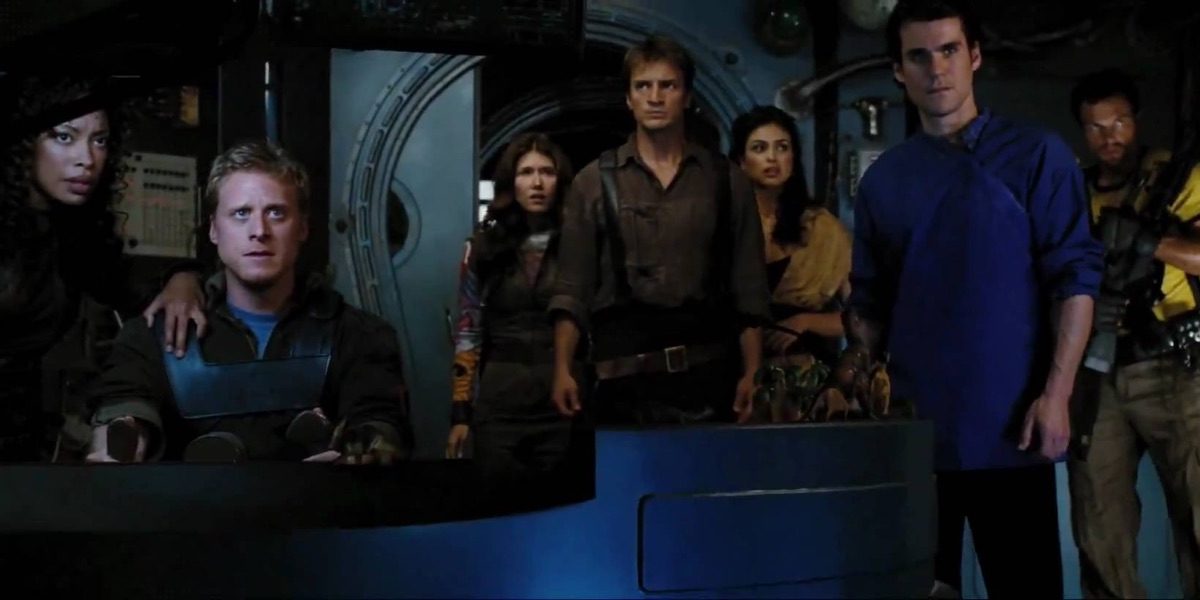

From there, a piece of the hull flies off, introducing our main character, Captain Malcolm Reynolds, and the pilot, Wash (played by anthropomorphic balls of sunshine, Nathan Fillion and Alan Tudyk, respectively). This immediately sets up the environment of the characters, with the ship being a character in its own right, by showing that Firefly-class ships are pieces of junk that barely hold together—like the Millennium Falcon, but with more consistent escape pods—and also how the crew is always at a disadvantage. The hairy situation leads to Mal sending an announcement to the crew on the intercom, prefacing it with “This is the Captain,” which shows he’s the one in charge—which is visually demonstrated already by standing on the bridge and overseeing the pilot—we then figure out pretty quickly that since it’s a Joss Whedon production, there’ll be lots of witty banter between the characters, as shown with Wash’s evaluation of the possibility that they might crash,
“This landing is going to get pretty interesting.”
“Define interesting.”
“(Sarcastic) Oh God, Oh God, we’re all gonna die.”
Then, Mal saunters through the ship and interacts with the crew. It gives the ship a sense of geography, showing where all the central locations are, which is essential considering large portions of the film take place on the ship. Mal goes from the bridge and past the bunks, where he runs into Jayne (Adam Baldwin) with a bunch of guns he wants to bring—excluding Vera, for some reason—showing that he’s the crew’s mercenary and that while he and Mal are friends, they occasionally are at odds. When Mal says he doesn’t imagine much action taking place, Jayne retorts, “What you plan and what takes place ain’t ever exactly been similar.” It’s done playfully, but it demonstrates that Jayne isn’t afraid to speak his mind to Mal and how things always seem to go wrong for the crew—it also mildly sets up Jayne’s brief antagonism later on. It also shows that Jayne respects Mal enough to do what he says since when Mal tells him no grenades—another great setup for later on—it makes Jayne groan in disappointment, but he does listen.
Mal then runs into his first mate Zoë (Gina Torres), who’s the only one who refers to him as “Sir”, showing off her respect for the chain of command and their shared military background, and with the brief banter, establishes that she and Wash are married, with Mal referring to him as your husband. Once again, the scene repeatedly makes the laissez-faire attitude of the crew clear with the prospect of the ship crashing. Jayne’s first reaction is, “We’re gonna explode? I don’t want to explode,” while Zoë’s introductory line is, “We crashing again?” This should be cause for panic, but this is just another day for them, so the scene is deliberately devoid of tension.
Mal then passes through the kitchen area—which, later on, will be the location of his most pivotal character scene in the film—and then walks down to the engine room to yell at his engineer Kaylee (Jewel Staite). Kaylee appears, saying that everything is shiny—part of the show’s vernacular, which is the equivalent of saying something is cool or okay—and showcases that she’s the engineer by…well, working on the engine, but it also solidifies that the ship being ramshackle isn’t a recent development, but an ongoing problem, with Mal yelling, “You told me those entry couplings would hold for another week,” and Kaylee retorting, “That was six months ago, Cap’n.”
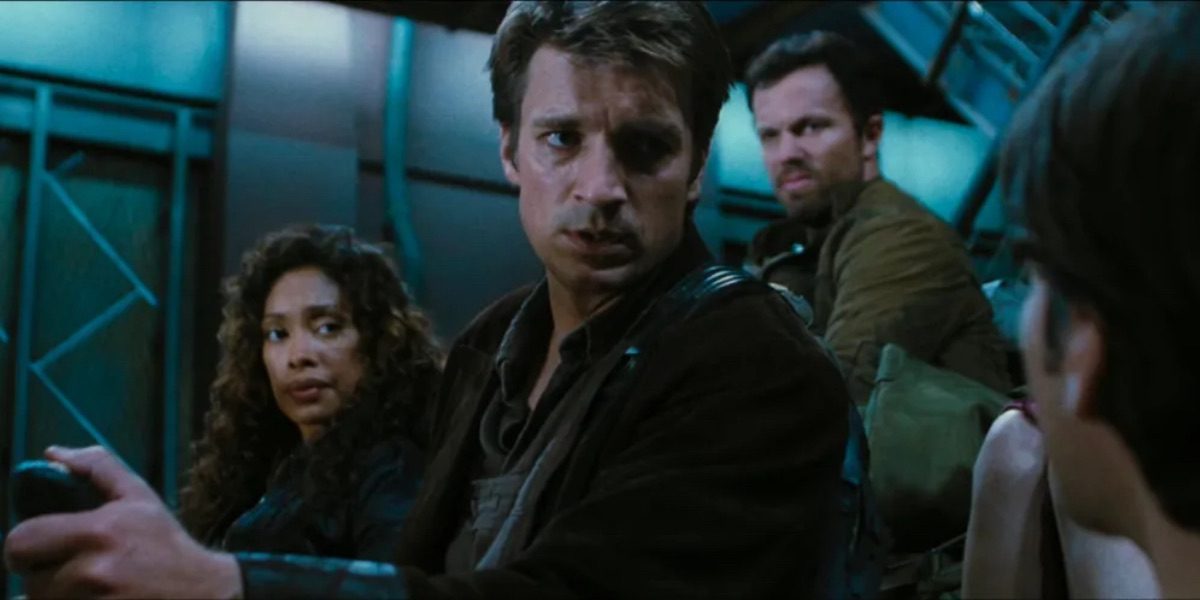

The scene also quickly demonstrates the older brother/little sister dynamic between the two. After he warns her, “My ship don’t crash. If she crashes, you crashed her,” she gives him a death glare that you absolutely wouldn’t give your boss, and he shuts up immediately. Her appearance is also relevant because she’s got engine oil all over her face and is wearing dark sleeveless overalls, a traditionally masculine attire for a position often associated with male characters—that being the field of futuristic spaceship repair—but underneath, she’s wearing a multicolored long-sleeve shirt, which sidesteps the tomboy stereotype that the character has always avoided. She may be a mechanic, but she still enjoys being able to express her femininity.
The clothing of all the characters is worth noting because none of the leads in the series wear traditional sci-fi clothes. There’s an unspoken casual dress code on the ship, and Jayne, especially, often wears T-shirts. Not futuristic space T-shirts, either (whatever that would look like). No, he wears proper graphic tees that you could find at Target, and Wash famously wears whatever the future equivalent of a Hawaiian shirt is. Does the Firefly universe have its own planet equivalent to Risa? Would they sell floral shirts? So many questions that could’ve been answered had the show kept going. (Note: That was a Star Trek reference, by the way. Risa… It’s a vacation sex planet in Star Trek.) The point is that regardless of the futuristic setting and the fact that the lead characters are ostensibly space cowboys—which is an excellent selling point to get people to watch the show—they’re still just people. It’s comparable to the characters in the original Alien being space truckers. They’re just people doing their jobs who also happen to live in a spaceship.
After talking with Kaylee, Mal runs into Simon, and the remainder of the scene is the two of them talking about River being involved with the heist they’re about to embark on. They walk past the lounge area—another critical moment will take place there later on—and go into the infirmary where Simon gives Mal a shot of… science. It doesn’t come into play at all; it just shows that Simon is the McCoy of the crew and acts as the ship’s doctor. This is the only redundant exchange in the scene because they talk about River and Simon being on the run and that River is a psychic. Both details were established in the cold open, but much like Kaylee’s moment in the engine room and Wash’s moment on the bridge, it visually shows Simon’s job on the ship in the location where he works. Also, while he and River are Mal’s crew, they’re the odd men out and are more like passengers who serve a purpose rather than vetted crewmembers. They enter the cargo bay, Mal walks away and says a bit of Chinese—another bit of culture-blending, as the universe has always combined a Western framework with Eastern traditions—and the shot ends with Simon walking up some stairs and finds River laying face down and barefoot on the walkway, showing off that she’s just a tad eccentric.
Barring the exclusion of establishing Shepherd Book (Ron Glass) as the ship’s moral compass and Inara (Morena Baccarin) as the ship’s resident professional [ahem] as well as being the woman Mal has a crush on, this scene does most of the grunt work on our key characters where exposition would’ve otherwise taken over. As for the rest of the important info, like the threat of the Reavers, the will they/won’t they relationship between Kaylee and Simon, and Mal and Zoë fighting with the Browncoats in a civil war against The Alliance, that’s all set up in the ensuing heist scene that immediately follows. Everything you need to know about these characters and this world is done within the first fifteen minutes in an abridged, Cliff Notes-style fashion and in a method that’s fun and doesn’t get in its own way. Most importantly, nobody ever utters the groan-inducing, expository words: As you know.

